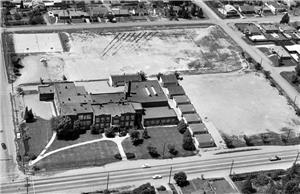This history of Broadview School is taken from the second edition of Building for Learning: Seattle Public School Histories, which includes histories of every school building used by the district since its formation around 1862. The original essay was written for the 2002 first edition by Nile Thompson and Carolyn J. Marr, and updated for the 2024 edition by HistoryLink editor Nick Rousso.
Broadview School
Oak Lake School District No. 51 was divided in half in 1911, with Oak Lake School taking students west of Meridian Avenue N and Olympic View taking those to the east. That same year new areas, such as North Park, were added to the district. The population increased so much that more school buildings were needed. In preparation for this expansion, a new site for the western third of the district was purchased in 1912. The land sat on the top of a hill with views of Puget Sound and the Olympics to the west and the Cascades to the east. Due to controversy among taxpayers at the northern and southern sections, Broadview School didn’t open until 1914.
Broadview School began as a small country school, but its planners envisioned a grander future. For the first five years of operation, only two of the four classrooms were used because the total enrollment averaged only 30 students in grades 1-6. Then, as hoped, the student population began to grow. The third classroom was needed in 1919, and the following year all four classrooms were used to hold grades 1-8. Over the next two decades, Broadview School continued to grow along with the population in this area north of the city. Five additions to the building were made between 1926 and 1948, increasing the number of classrooms to 20 and adding an auditorium/playroom, lunchroom, and play court. Once a week 8th grade boys went to Oak Lake School for manual training classes, which had the proper facilities. A music teacher rotated among several schools in the district and gave weekly music lessons.
Broadview became part of Shoreline School District No. 412 in 1944. In 1953-1954, enrollment was so high that the 5th and 6th grades were sent to Butler Junior High School in the Shoreline School District. They returned the following year after Broadview entered the Seattle School District when the neighborhoods north of N 85 Street were annexed into the City of Seattle. Their return was made possible by the opening of Viewlands School, which shifted Broadview’s southern enrollment boundary from 105th N to 117th N. During its highest enrollment years in the late 1950s, as many as 12 portables stood on the north and northwest sides of the building. These were replaced in 1961 when a brick addition was erected along the east side of the older building. The new structure featured 14 classrooms and administrative and health areas. At the same time, the older structure was completely remodeled.
In fall 1966, as part of the voluntary racial transfer program, 25 Black students transferred to Broadview from Mann and Minor, entering a school where only two Black students had attended the previous year. The following year, when 88 Black students attended Broadview, an attempt was made to place at least one transfer student in every classroom.
Language learning disability classes were introduced in 1970. Following a community planning process, an alternative program called Broadview II began in 1972, utilizing three classrooms and serving grades 1-6. The alternative program, which had 103 pupils in 1974-1975, was based on the open-school concept where children learn at their own pace. Additionally, education opportunities were “opened up” by giving students an avenue to study projects of their own choosing and to have greater contact with the community. Principal Amie Loughlen retired in 1973 after 20 years at the school and the learning resource center was named in her honor.
Under the district’s mandatory desegregation program, in 1978, Broadview was paired with Muir and became a K, 4-6 program, while Muir housed grades 1-3. This boosted the racial mix at Broadview.
The school was closed in June 1981. Unlike students at other schools closed that year, Broadview students were not dispersed to other schools. The entire Broadview program of 372 students and teachers were moved up the street to Thomson, which had been a junior high school until that program closed the same year. When Broadview students relocated to their new home, the Thomson school was renamed Broadview-Thomson Elementary.
By early January 1981, the First Church of the Nazarene had signed a management agreement with the district and used the Broadview building for its youth activities. Subsequently, the former school buildings were sold and demolished. Opened on the site in November 1990, the Ida Culver House Broadview was a home intended for retired teachers. It was named after a former John B. Allen teacher who helped establish the first retirement residence for Seattle teachers.
History
Broadview School
Location: 12515 Greenwood Avenue N
Building: 4-room brick exterior with wood interior
Architect: n.a.
Site: 3.58 acres
1914: Opened by Oak Lake School District
1926: Site expansion and addition (n.a.)
1928, 1935: Additions (n.a.)
1937: Site expanded to 8.58 acres
1944: Formed part of Shoreline School District
1946, 1948: Additions (n.a.)
1954: Annexed into Seattle School District
1961: 14-room brick addition (n.a.) opened
1981: Closed in June; management agreement
1985: Leased
1987: Sold to ERA Care
1989: Demolished
Use of Broadview School site in 2023
Ida Culver House Broadview

